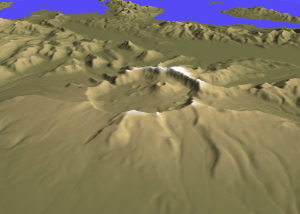| Aniakchak Caldera | |
|---|---|
 Mount Aniakchak caldera | |
| Highest point | |
| Elevation | 1,341 m (4,400 ft) |
| Coordinates | 56°53′N 158°09′W / 56.88°N 158.15°W[1] |
| Geography | |
| Location | Aniakchak National Monument and Preserve, Alaska, US |
| Parent range | Aleutian Range |
| Topo map | USGS Chignik D-1 |
| Geology | |
| Mountain type | Caldera (Stratovolcano) |
| Volcanic arc/belt | Aleutian Arc |
| Last eruption | May to June 1931 |
| Designated | November 1967 |

Mount Aniakchak (Russian: Аниакчак) is a volcano on the western Alaska Peninsula. Part of the Aleutian Volcanic Arc, it was formed by the subduction of the oceanic Pacific Plate under the North American Plate. Aniakchak is a 10 kilometers (6.2 mi) wide caldera with a break to the northeast. The caldera contains Surprise Lake and many volcanic cones, maars and craters, including Vent Mountain. The volcano has erupted mainly calc-alkaline rocks ranging from basalt to rhyolite.
Activity began in the Pleistocene. Aniakchak is one of the most active volcanoes in Alaska and underwent several significant caldera-forming eruptions. The largest eruption is known as Aniakchak II and took place in 1628/1627 BCE. During this eruption, pyroclastic flows swept all the flanks of the volcano and caused a tsunami in Bristol Bay. Tephra from the eruption rained down over Alaska, with noticeable deposits being left as far as northern Europe. The eruption depopulated the central Alaska Peninsula and caused cultural changes in Alaska. Together with other volcanic eruptions at that time, Aniakchak II may have caused climatic anomalies. The present-day caldera formed during this eruption. A lake formed in the caldera, which drained in one of the largest known floods of the Holocene. Many lava domes and cones were emplaced within the caldera after the Aniakchak II eruption, with some events depositing ash over Alaska.
The last eruption took place in 1931. It was intense, forming a new crater in the caldera and causing ash fallout over numerous towns in Alaska. The volcano is monitored by the Alaska Volcano Observatory (AVO). The area around the volcano is the Aniakchak National Monument and Preserve, maintained by the National Park Service.
- ^ Pearce et al. 2017, p. 305.
